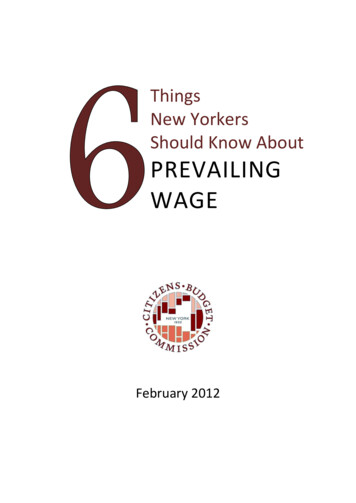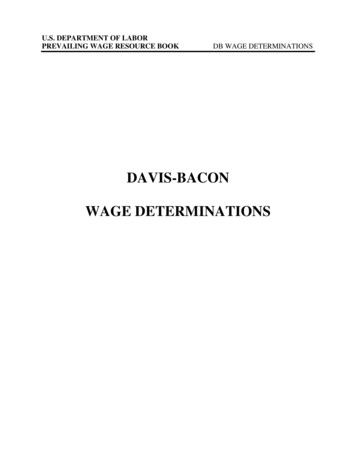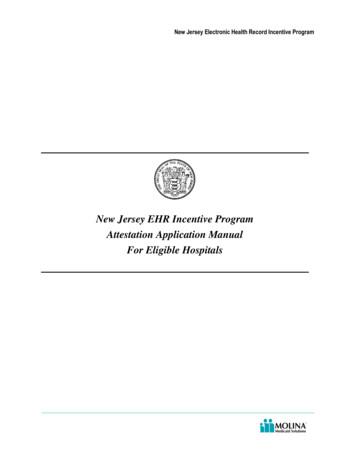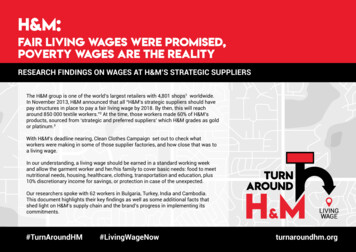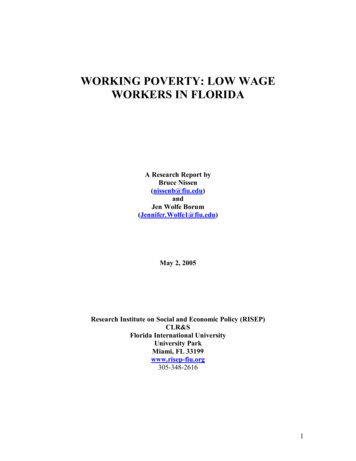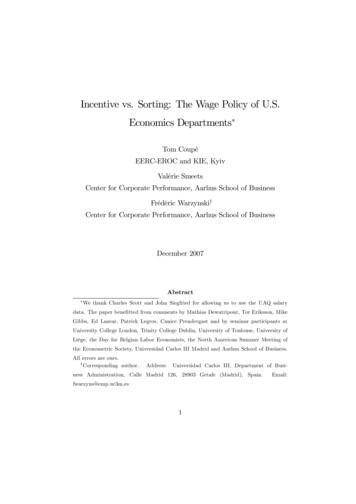
Transcription
Incentive vs. Sorting: The Wage Policy of U.S.Economics Departments Tom CoupéEERC-EROC and KIE, KyivValérie SmeetsCenter for Corporate Performance, Aarhus School of BusinessFrédéric Warzynski†Center for Corporate Performance, Aarhus School of BusinessDecember 2007Abstract We thank Charles Scott and John Siegfried for allowing us to use the UAQ salarydata. The paper benefitted from comments by Mathias Dewatripont, Tor Eriksson, MikeGibbs, Ed Lazear, Patrick Legros, Canice Prendergast and by seminar participants atUniversity College London, Trinity College Dublin, University of Toulouse, University ofLiège, the Day for Belgian Labor Economists, the North American Summer Meeting ofthe Econometric Society, Universidad Carlos III Madrid and Aarhus School of Business.All errors are ours.†Corresponding author.Address:Universidad Carlos III, Department of Busi-ness Administration, Calle Madrid 126, 28903 Getafe (Madrid), Spain.fwarzyns@emp.uc3m.es1Email:
In this paper, we propose a series of empirical tests that try to assesswhich of the various theories that have been designed to explain thewage policy of firms better suits economics departments. We considertwo closely related incentive theories -tournaments and standards- andlearning theory. We use a dataset of average wages by rank in U.S.economics departments over the period 1977-1997 and link this information to individual production data. We analyze what are thedeterminants of the wage structure and what are the effects of thesepolicies on the behavior of economists. We find that the wage gap isincreasing along the hierarchy, even when controlling for differencesin production between ranks. Moreover, wages are more sensitive toproductivity for higher ranks. We find some evidence that higher wagegaps lead to higher productivity but not that wage gaps depend onthe number of contestants nor that they lead to less cooperation. Ourfindings provide evidence in favor of all these theories, but our tests aredesigned to distinguish between their different effects. In particular,we find that, while on average, departments appear to use standardsrather than tournaments, the choice between the two depends on thetype of promotion, department quality and who else the departmentcan hire.JEL Codes: J0, M5Keywords: incentives, sorting, tournaments, standards, learning,selection, economic departments2
“No matter what we may say, none of us is a philosophersaint, and you can’t fully understand the development of economic ideas without a sense of the structure of rewards thateconomists face”,Paul Krugman, Incidents from my career,www.wws.princeton.edu/ pkrugman/incidents.html1IntroductionWhat are the firms’ concerns regarding their wage and promotion policies?Theory suggests that they care about providing incentives to workers (e.g.Lazear and Rosen, 1981) while avoiding dysfunctional responses or lack ofcooperation (e.g. Lazear, 1989); about providing incentives to invest in human capital (e.g. Prendergast, 1993); about learning about workers’ abilitiesand selecting the most able (e.g. Gibbons and Farber, 1996), assigning individuals to their most productive use (e.g. Rosen, 1982) and paying themaccordingly. Wages therefore are set for incentive purposes, but also as aconsequence of a learning and selection process within the organization.Empirical tests to date have mostly focused on testing implications fromone or another of these theories, without systematically trying to distinguishbetween them. This limitation has been noted in recent surveys of empiricalcontract theory (Gibbs, 1994; Gibbons, 1997; Prendergast, 1999). One noticeable exception is Baker, Gibbs and Holmström (1994b). Using individualdata from a single firm, they describe the key elements of the wage policy ofthis firm and link them to what different theories (learning, on-the-job human capital acquisition and incentives theories) would have predicted. Theyconclude that their findings are not entirely compatible with any of thesetheories considered separately, suggesting as an alternative to combine them3
in a single framework. This work, together with their companion paper, hasgenerated a new line of theoretical research integrating building-block models (learning, task assignment and on the job human capital acquisition) toexplain some of these (previously unexplained) findings, which has been relatively successful achieving this aim (Gibbons and Waldman, 1999a, 1999b,2003).In this paper, we analyze the wage policy of U.S. economics departmentsover the period 1977-1997. Through a series of empirical tests, we try tobetter understand which theories can be helpful to explain the wage policy ofeconomics departments. We consider two closely related incentives theories- tournaments and standards - and learning theory leading to selection andsorting1 . We focus our analysis on symmetric learning but also discussimplications from asymmetric learning. We ignore task assignment since aspecificity of the academic labor market is that individuals are not assignedto different tasks when they are promoted. We also consider explicitly theoutside labor market to allow policies to change according to the supply ofadequate candidates, both inside and outside the firm.Up-or-out contracts are another specifity of the academic labor market.The literature has typically considered this type of contracts to be a credibleway to solve the double moral hazard problem where the firm wants theemployee to invest in human capital and the employee wants the firm tocommit rewarding him for this investment (Kahn and Huberman, 1988).Prendergast (1993) and Ghosh and Waldman (2004) note that promotionswill not provide sufficient incentives for firms if not accompanied with a taskreassignment where human capital is more valuable. For occupations likeacademia, where this can be seen as a realistic assumption, up-or-out will1We also discuss implications of human capital theory, although it is less central in ourempirical analysis. The reasons are clearly explained in section 4.4
do a better job. On the other hand, tenure and promotion decisions arealso considered as a way to select individuals for their ability and provideincentives to workers. For these purposes, tenure is a tool complementary topromotions. In practice, in many universities, tenure is offered at the sametime than the promotion to associate professor. Therefore, while promotions(and tenure) are used as incentives and selection mechanisms in academia,up-or-out contracts offer a better way to induce individuals to invest inhuman capital.Economists studying the U.S. academic labor market have discussed therelevance of these theories. First, while there seems to be some support forthe fact that departments use promotion and tenure2 prospects to provideincentives to younger workers, and while the type of contest looks like a relative performance evaluation (many players competing for a prize associatedwith promotion), it is relatively unclear whether the evaluation is done relative to a fixed pre-established threshold or to the performance of the othercontestants. Another aspect that needs to be clarified is the influence of external recruitment on the provision of incentives to insiders. An importantadvantage of subjective and also relative performance evaluation - particularly relevant in the academic environment- is that, despite the fact thatresearch performance is publically observable, it allows to incorporate otherdimensions of the job (teaching, externalities,.) when ranking individuals.Second, departments also appear to learn whether younger members havethe ability to be promoted to a higher rank, leading to a selection processthrough which higher ability candidates are allocated to the highest rankswhere their skills are rewarded. Related to this, a strand of research hasestimated how wages varied with past cumulative performance, indicating2Another specificity of academic labor markets is the use of up-or-out contracts asso-ciated with the tenure system (Kahn and Huberman, 1988). We discuss how it relates toour analysis in section 4.5
that the market rewards the ability to publish research (see e.g. Moore,Newman and Turnbull, 2001 for a recent exercise). Our empirical analysis considers these different theories in a single integrated framework, in thespirit of Gibbons and Waldman, adapted to the peculiarities of the academiclabor market.We try to answer two questions: first, what are the main determinantsof the wage policy of economics departments; second, and more importantly,does the wage structure influence the “behavior” of economists. To answerthese questions, we link our “average wage by rank” dataset to individualproductivity and cooperation data to assess the causes and consequences ofwage gaps. We use the composition of economics departments in the 107universities which were ranked by the NRC in 1993 and link the names to thebibliographic information provided by EconLit. We also use the fact thatwe have information on the entire population of the department to computethe average productivity by rank. This is important because it allows us tolink wage gaps to differences in past productivity between ranks, thereforecontrolling for the selection effect.Results show that selection and incentives matter in economics departments, but also that, to identify the effects of one theory, empirical workhas to control for other potential explanations. Our findings also suggestthat, while on average, departments appear to use standards rather thantournaments, the choice between the two depends on the type of promotion,department quality and who else the department can hire.The next section describes the empirical methodology and discusses theimplications of the various theories. We then describe our unique dataset,carry on our empirical analysis and discuss the implications of our results.6
2Theory and Empirical PredictionsThis section compares implications from tournament theory, standards, andlearning and selection theory. It also discusses the intuition of our empiricalstrategy to distinguish between these three theories.2.1TournamentsTournaments are a simple form of relative performance evaluation (RPE)where people get promoted if they are ranked first and beat their competitors. The prize associated with the promotion generates incentives to exerteffort. This theory has been applied to promotions along the hierarchy, mostimportantly to describe CEO succession but also more generally to describethe allocation of individuals to higher responsibility levels along the hierarchy through sequential contests. An important prediction of tournamenttheory is that the value of winning should increase as one goes up the promotion ladder (Rosen, 1986). The intuition is that in a sequential game withrisk averse agents, N stages and s stages remaining to be played, prizes areincreasing in survival: Ws 0 s. Winning one step further gives theoption to continue, but since there are fewer steps remaining, the optionvalue that determines the incentives of the players plays out, so the wagegap must reflect the loss of the survival option3 .Another prediction of tournament theory with a single prize is that thewage spread should be higher the more there are contestants for the prize(see McLaughlin, 1988 for a discussion; see also Nalebuff and Stiglitz, 1983).3Under risk neutrality, the incentive maintaining prize structure consists of constantprizes until the last promotion, where there is discrete jump. Such a wage distributioncan also be seen as a result of repeated static tournaments rather than the generation ofan option in repeated tournaments (Prendergast, 1999).7
This is a very intuitive finding: the more people are fighting for a prize, theharder it is to win it, and the higher the prize should be to provide the samelevel of incentives. While equilibrium effort is not affected, the wage spreadis increasing in the number of contestants. As noted by Eriksson (1999), it isless obvious to find how the level of effort affects the probability of winningas the number of contestants increases4 .The most direct implication of tournament theory is that effort is increasing with the prize, therefore higher wage gaps should be associatedwith higher productivity. However, higher wage gaps can also reduce cooperative behavior among contestants (Lazear, 1989). It might therefore beefficient to have lower wage gaps to avoid this negative sabotage behavior,at the expense of lower productive effort.The empirical literature testing tournament theory has found supportfor some of these implications, focusing on top executives (see e.g. Eriksson, 1999; Conyon et al., 1999 and Bognanno, 2001 for recent exercises),selecting by construction only the absolute top of the hierarchy and proxying individual productivity by firm performance; or more naturally on sporttournaments (see e.g. Ehrenberg and Bognanno, 1990a&b and Becker andHuselid, 1992), where individual performance is immediately retrievable,but hierarchies are absent. However, the most important criticism againstexisting papers is that most studies did not test tournaments against othertheories5 like standards or theories of hierarchical production where workers4Allowing for multiple prizes further complicates the analysis. See Gibbs (1996) for adetailed analysis.5O’Reilly, Main and Crystal (1988) test tournament theory against social comparisontheory. Lambert, Larcker and Weigelt (1993) test tournaments together with managerialpower and agency theory. Main, O’Reilly and Wade (1993) test tournament theory againstwage compression. However, none of these papers consider standards as an alternative totournaments, nor try to distinguish incentives from selection effect.8
are assigned to their most productive use. These theories can have similarpredictions (Gibbs, 1994, 1996; Prendergast, 1999). A way to cope withthis problem has recently been advanced by Eriksson (1999). He proposedto test multiple predictions from tournament theory with the same dataset.He argues that this provides a sharper test of tournament theory becausethe alternative theories do not generate all the same predictions. While wealso test multiple predictions from various theories, we follow a different approach: we run a series of empirical tests that try to distinguish between theeffects of these different theories. We see this as the main contribution of thepaper. The academic profession combines two important aspects that are vital for our analysis. First, individuals are allocated within a well-establishedthree-layers hierarchy. Second, we can measure individual research productivity and cooperation since entry on the labor market, and, therefore, ateach hierarchical level, by looking at publications patterns. We discuss inthe rest of the section what other theories predict and how our empiricalanalysis allows to distinguish between them.2.2StandardsStandards are another simple form of promotion scheme, where all individuals who reach an established threshold are promoted6 . Instead of beatingtheir competitor (a moving target), workers must now beat the standardestablished ex ante by the firm. Therefore the wage gap has the same incentive property than in the tournament model. It is also still the casethat the wage gap is increasing, following the same reasoning. However,the other contestants of the game are not true competitors if the standardis fixed, therefore the number of contestants should not be associated withhigher wage gaps, nor should higher wage gaps be associated with less coop6The discussion is based on Gibbs (1996).9
eration. Standards are therefore a safeguard against the potential negativesabotaging effects of tournaments.There are other differences between standards and tournaments that areworth stressing. First, standards do not filter out the common term. Whenthere is a lot of common uncertainty, tournaments provide a form of insurance from the external environment. Second, by imposing a minimum levelof absolute performance, standards provide a better selection of individuals than tournaments. Third, under tournaments, the number of positionsavailable is fixed while it varies according to performance in the case of standards. Therefore, if a position needs to be filled, firms are more likely toresort to tournaments.2.3Learning, Selection and SortingIn learning theory (See Gibbons and Katz, 1992; Farber and Gibbons, 1996;see also the discussion in Baker, Gibbs and Murphy, 1994b), firms are initially uncertain about the ability of their workers when they hire them. Byobserving their performance, they gradually extract information about workers’ ability. An important consequence of learning theory is that individualsare selected to be promoted on the basis of their expected ability. In firms,learning about ability can be especially important if ability is more valuablein the higher levels of the hierarchy. Selected individuals are then rewardedaccording to their marginal productivity. Importantly for our analysis, theacademic labor market differs from that description on at least two key aspects. First, unlike what happens in most firms, economists do the samejob in all layers. A promotion is not associated with a new task assignment,at least not to the same extent than in firms. Individuals in lower levels arenot really subordinates who receive orders from individuals in the higher10
ranks. However, talent in the high ranks can generate positive externalitieson those below them. Second, the literature studying individual wages inthe academic labor market has shown that economists are not paid according to their marginal research productivity. Instead, individual wages in theacademic labor market are set on the basis of past achievements or “reputational capital” (Moore, Newman and Turnbull, 2001). Increasing wage gapscould then also reflect the fact that higher ranked individuals have been selected based on their past productivity. By the same token, if the more ableindividuals are sorted in the higher wage universities and if individuals havereached the higher ranks following a selection process, then the fact thathigher wage gaps lead to higher productivity could also be a consequenceof the sorting effect, rather than reflecting the incentive effect. This theoryof learning and selection has no clear implication concerning the effect ofthe number of contestants on the wage gap or the effect of the wage gap oncooperation. What is important though is to control for the selection effectif we want to test implications from the other theories.2.4Our ApproachOur empirical strategy is the following. We test 1) whether wage gaps areincreasing along the hierarchy; 2) whether the number of contestants hasan effect on the wage gap; whether higher wage gaps are associated 3) withhigher research productivity and/or 4) less cooperation. We compare theresults with what standards and tournament theory would predict, controlling (and testing) for learning and selection theory. As shown above, thesetwo incentive theories have conflicting implications regarding the effect ofthe number of individual by rank on the prize and the consequences of thesize of the prize on cooperation. We control for selection by disaggregatingthe wage gap in two components: one part that reflects past productivity11
differentials and a residual that reflects incentives. The procedure is described in details in section 4. We then analyze the importance of externalrecruitment and look at the effect of department quality on the wage policy.This brings additional light on our results.3Data3.1University Level DataEvery year the American Economic Association (AEA) sends to economicsdepartments the Universal Academic Questionnaire (UAQ) where information is asked on, among other things, average salaries by category of jobs(assistant, associate and full professors), the size of the department by category and the number of degrees awarded.We use the answers to these surveys for the years 1977 to 1997, providinga total of 2,100 observations7 or on average 100 departments a year. Salariesare deflated using the GDP-implicit price deflator (the base year is 1998).Average real wages have increased over time for all 3 categories. In 1977,an economics department paid on average 64,000 to its professors, in 1997it was about 85,000 . The average wage for associate professors increasedfrom 48,000 to 63,000 and from 38,000 to 53,000 for assistant professors.Figure 1 shows the evolution of the average wage gap. While the wage7Unfortunately, only few departments have participated every year so we have an un-balanced panel. From 2,338 university-year pairs, we further excluded observations wherewe did not have information on all ranks (186 cases), where the average salary was less then10,000 (8 outliers), and where the natural rank order was not observed (44 -mostly whenassistant professors average wage was higher than associate professors wage). Results werenot affected by the cleaning.12
difference between associate and full professors has remained quite constantover time, the gap between assistant professors and the other categories hasdecreased over time. More importantly for our analysis, this indicates thatthe average wage gap is increasing with the job level: in 1998, on average,the gap between the salary of an assistant professor and the salary of anassociate professor was about 19% while the gap between the salary of anassociate professor and the salary of a full professor was about 35%.Another interesting feature of our dataset is that the variance increaseswith rank as well (Table 1). This could suggest that promotions lead to paydifferentiation, while pay is relatively similar at the assistant professor level.These stylized facts can be explained by incentives, learning or humancapital theories, as discussed in the introduction. We test their relevance inthe next section.3.2Internal Labor Markets and External CompetitionThe UAQ also provides information on the number of hires, promotions andleaves by year and by rank. Using all observations for which we have dataon the number of faculty in t and t 1, and on the internal and externalmoves, we compute three variables: the percentage of individuals leavingthe department by year and by rank, the percentage of individuals new intheir rank (promoted from the inside or hired from the outside) by year andby rank, and the percentage of newly hired individuals coming from outsidethe department by year and by rank. Table 2 shows the average of thesethree variables.13
Figure 1: The evolution of the gaps between different ranks8070605040302010197519801985199019952000– associate vs assistant prof vs associate *** full prof vs assistantTable 1: Average wage and standard deviation by rankMeanStd. 8,27214
Table 2: Average internal and outside mobilityRank% of individuals% of individuals% of individuals new in theirleaving the departmentnew in their rankrank hired from the outsideProfessors3.6 %5.5 %28 %Associates3%12.1 %25 %Assistants11.3 %19.1 %95.8 %The average percentage of individuals leaving the department is relatively small for associate and full professors, but much higher for assistantprofessors. On the other hand, the average percentage of individuals whoare new in their rank is decreasing with rank, and very large at the assistantprofessor level. Moreover, 96% of the new assistant professors are hired fromthe outside, this percentage decreases dramatically with rank. These statistics are consistent with the idea of internal competition for jobs. But aroundone quarter of new individuals are still hired from the outside at the higherranks, suggesting that external competition also plays a non negligible role.We therefore include it in our empirical analysis.3.3Individual DataWe further use information about the entire population of individuals relatedto 107 universities which were ranked by the NRC in 19938 . This datasetcontains 2,673 individuals and provides the name, rank and university to8As a robustness check, we also used the 7th and the 9th edition of the Guide toGraduate Study in Economics to get information on the faculty of the departments. The7th edition (academic years 1982-1984) gives for each department, the names of the facultyand their rank (from assistant to full professor). The 9th edition (academic year 1994-1995)in addition gives information on the date and the university of Ph.D. though sometimeslacks information on ranks. In a longer version of the paper, we also show the resultsusing this alternative source.15
which they are affiliated during the academic year 1992-1993. These nameswere linked to the bibliographic information in EconLit. This allows usnot only to look at the performance of individuals in terms of research butalso gives us the possibility to look at their cooperative behavior (throughcoauthorship).The department composition, together with the bibliographic record ofeach individual, was then matched with the wage dataset. Wages for eachlayer were available for 50 universities, among them 13 are private. Thisprovides information about 1,291 individuals. More than half of them arefull professors (694 individuals or 53.8% of the sample), the category ofassociate professors is composed of 292 individuals (or 22.6% of the sample)and the others are assistant professors (305 individuals, or 23.6% of thesample).44.1Empirical AnalysisIncreasing Wage GapsOur first test is to determine whether the wage gap is increasing along thepromotion ladder. We look at the effect of the job level on average wage andtest whether the coefficient is increasing. We regress the log of average wageon a dummy for associate, a dummy for full professor and some controls.log Wjrt α0 α1 ASSO α2 P ROF α3 Zjt εjrt(1)where j is an index for the university, r is an index for rank (r P ROF ,ASSO,ASST ) and t is a time index. The variables included as controls (Z)are a dummy for private universities and the size of the university (measuredby the number of degrees awarded, in hundreds), the latest being slightlyless well reported. Results are presented in table 3.16
Table 3: Wages and ranksDep.var.: log W(1)(2)ASSO0.20 (0.005)0.20 (0.004)P ROF0.49 (0.005)0.49 (0.004)Nr.BA-0.07 (0.004)P RIV-0.05 (0.002)constant10.63 (0.004)10.57 (0.004)Year dummiesNOYESNr.Obs.63005721Adj. R20.560.75Note: standard errors in parentheses, ***/**/* denotes statistical significance at the 1%/5%/10%levelWe find evidence of an increasing relationship between wage and thejob level. As one moves up in the hierarchy, the gap increases. As can beseen in the first column, job levels alone explain 56% of the variance. Sizeof the institution and its ownership also play an important role in wagedetermination.The finding that the wage gap is increasing can be explained by varioustheories. Sequential tournaments and standards both generate the implication that the prize associated with promotions should be increasing alongthe hierarchy. However, wage differentials could simply reflect differences inlife-time achievements if individuals at the top of the hierarchy have beenselected on the basis of their productivity. Finally, human capital theorywould also predict that wages increase with experience. Therefore, increasing wage gaps could also reflect differences in human capital accumulation.To control for selection, we need a measure of performance for each17
hierarchical layer. To disaggregate university production by category of job,we use the list of the names and the ranks of individuals working in thedepartment as provided in the 1993 survey of the NRC. For each individual,we constructed the publication history between 1969 and 1998 from EconLit.This allows us to compute the mean number of publications per rank for eachof the 107 doctoral programs included in the NRC survey.Publications are adjusted for quality and corrected for coauthorship, dividing the weight of the paper by the number of coauthors. Different qualityweights have been proposed in the literature. We selected one methodology,suggested in Bauwens (1998): each journal receives a weight between oneand five on the basis of the product of the impact factor and the total number of citations received during a given year (the latter reflecting better thelong run) and then gives weight 1 to journals not included in the JournalCitation Report (JCR) but included in Econlit, because the non-JCR included journals are quite likely to be rarely cited ones. This method has theadvantage of being simple and of weighting all journals. One disadvantage isthat weights can be seen as relatively subjective. We also used publicationsweighted by the impact factor of the journal and obtained similar results.We link the cross section information on the composition of economicsdepartments and their publication to the information about wages for theyear 1992. We find a match for 50 universities. It is important to stress onceagain that, while we gain some insight on the potential variables influencingwages, we lose the time dimension. We were unfortunately not able to followthe career of individuals9 as the survey was not continued in subsequentyears.9In Coupé et al. (2006), we follow the career of a sample of 1,000 top economistsand linked their productivity to their career achievements, but without information aboutindividual wages.18
To control for the possibility that wage gaps reflect differences in averagepast publications, we create a variable called average past publication byrank (P P U B) by summing all papers published from 1969 until 1992 ofthose individuals present in university j and rank r in 1992, and dividingthe sum by the number of individuals by rank. We then regress the log ofwage by rank on the log of P P U B by rank,
University College London, Trinity College Dublin, University of Toulouse, University of Liège, the Day for Belgian Labor Economists, the North American Summer Meeting of the Econometric Society, Universidad Carlos III Madrid and Aarhus School of Business. All errors are ours. †Corresponding author. Address: Universidad Carlos III .


